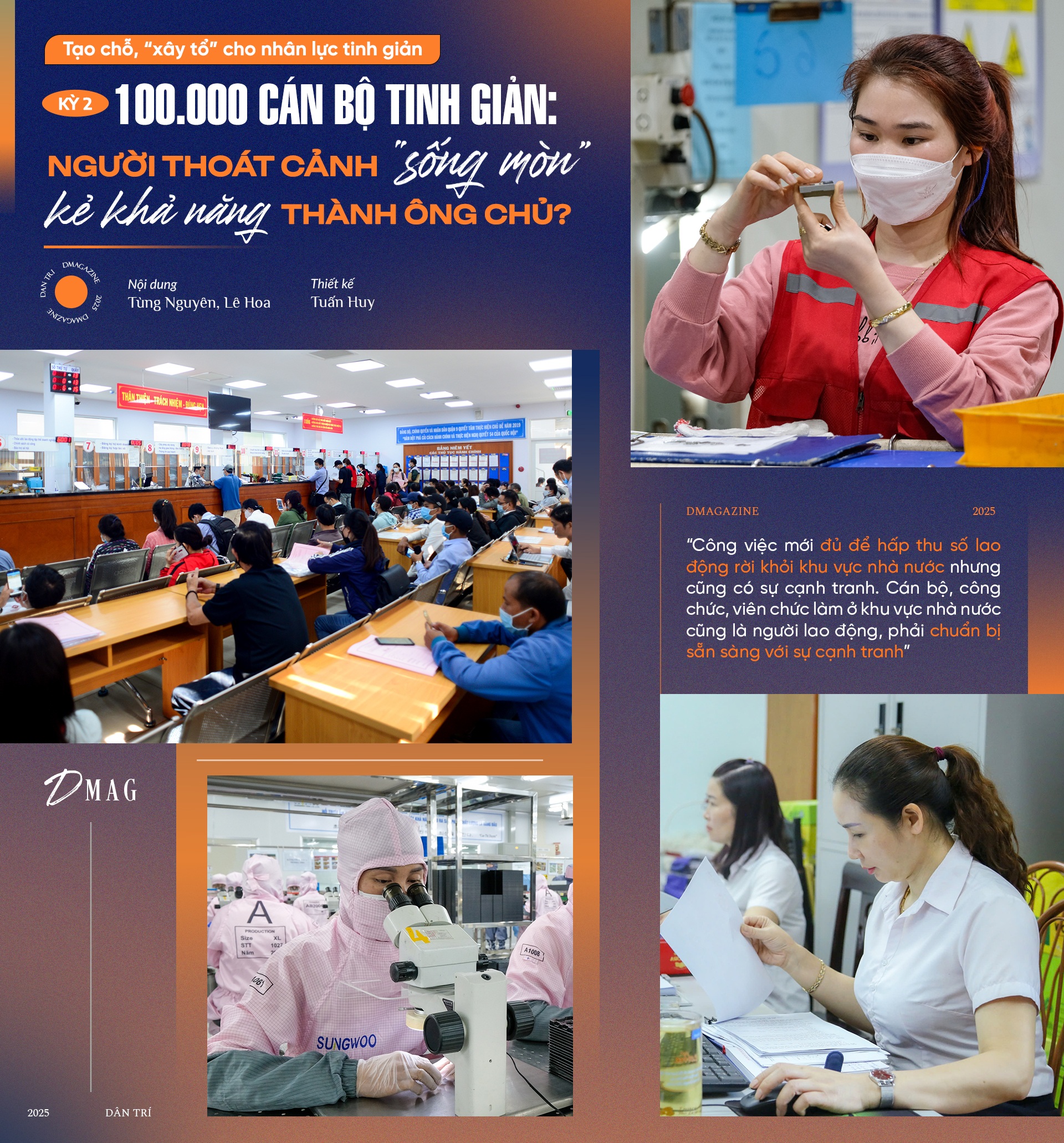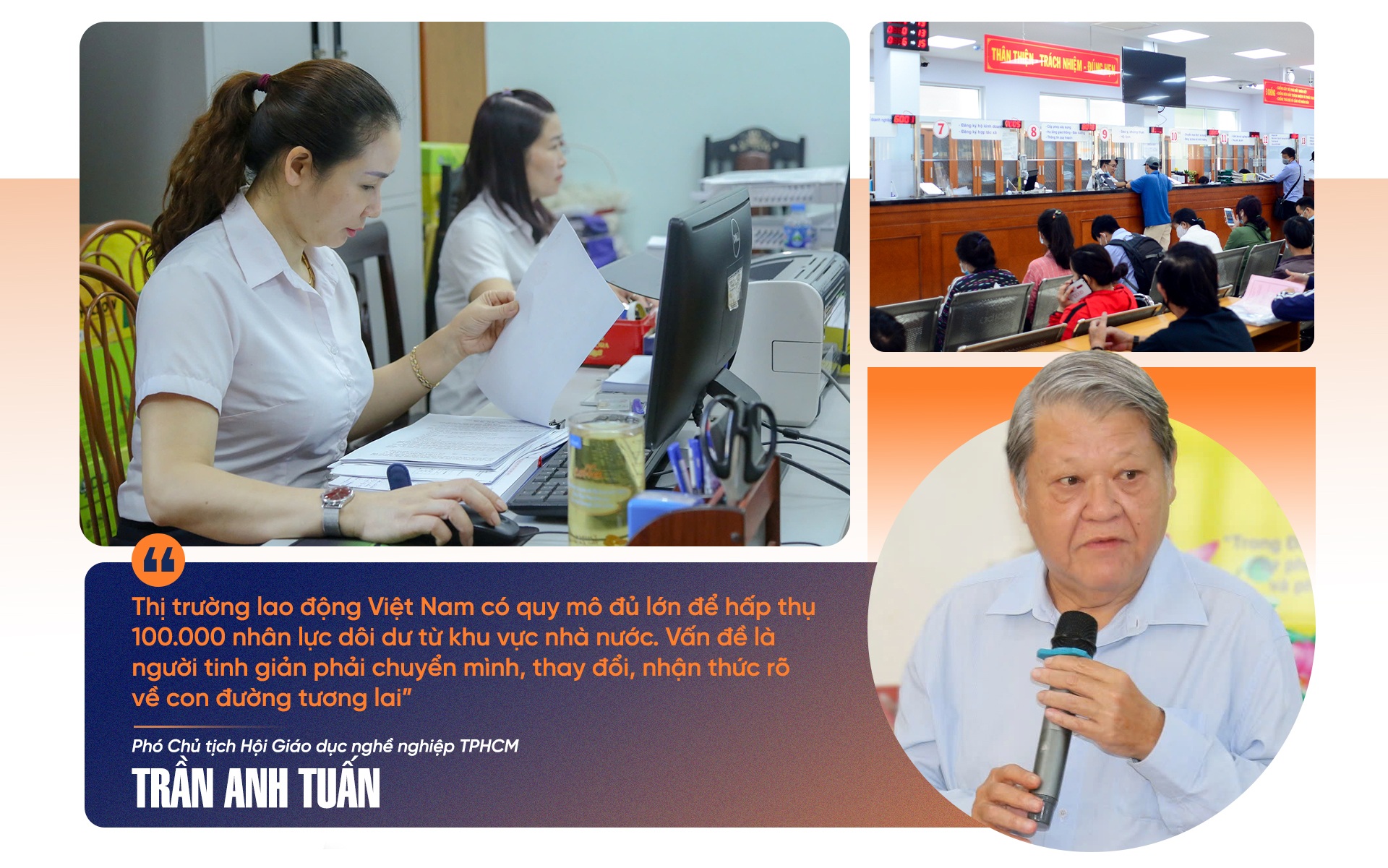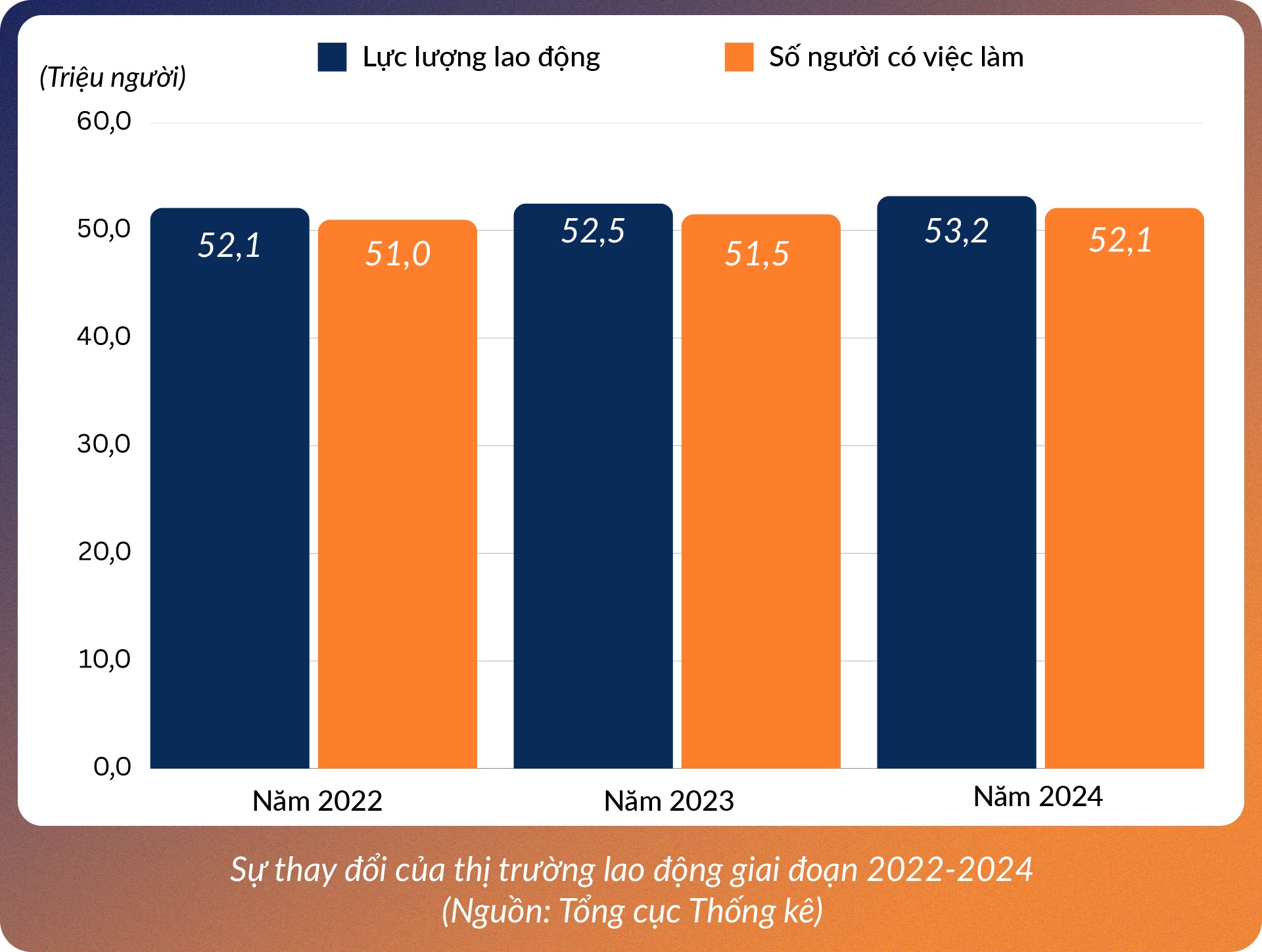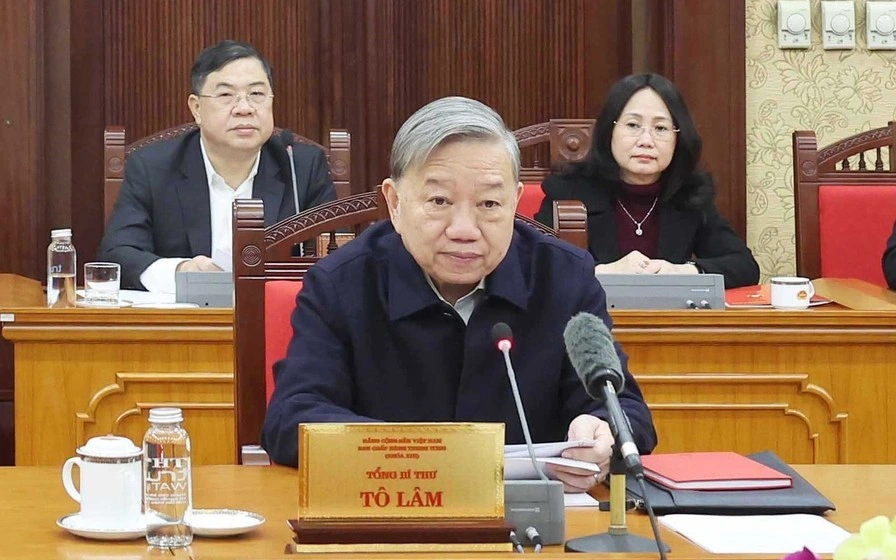

As an expert with more than 40 years of experience in the field of labor and employment, Mr. Tran Anh Tuan, Vice President of the Ho Chi Minh City Vocational Education Association, paid special attention to and was interested in the direction related to the development of the labor market of General Secretary To Lam at the beginning of this year.
Mr. Tuan is concerned about the information about a group of workers about to leave the state sector with a size of about 100,000 people and the impact on the job market.
Giving a positive assessment, Mr. Tuan said that the Vietnamese labor market is large enough (more than 53 million people, increasing by an average of more than 500,000 people each year) to absorb the above-mentioned workforce. It is important to have appropriate plans and policies to effectively regulate the market.

Mr. Tuan said: "The year 2025 is considered to have many socio-economic advantages for the labor market to continue to develop positively, with higher growth rates and lower unemployment rates... Forecasts show that the Vietnamese labor market is making certain progress. Many industries and fields are creating more jobs and can absorb more workers."
According to Mr. Tran Anh Tuan, in the labor market, labor force fluctuations are frequent, with people coming in and out, and human resources moving from one place to another. Especially in private enterprises, on average, every year, for every 3 newly recruited workers, 2 people who previously worked at the enterprise move to another place. The rate of workers quitting, leaving their jobs, changing jobs and the rate of recruiting new workers is very high, averaging 18%-20% per year.
Therefore, changing jobs is very normal for employees. People working in the public sector must also get used to change, to fluctuations and need to have a clear awareness to orient their future path.
According to the General Statistics Office, in 2024, the labor force aged 15 and over will reach 53.2 million people, an increase of more than 625,000 people compared to 2023. The labor market in 2024 is very stable with 51.9 million employed workers, an increase of 585,000 people (equivalent to an increase of 1.14%) compared to the previous year.

"In fact, every year the whole country has millions of new jobs. Ho Chi Minh City alone creates jobs for more than 300,000 people each year, creating about 150,000 new jobs. Comparing those numbers with the 100,000 cadres being streamlined this time, we see that there is no need to worry about the ability to absorb the number of workers leaving the state sector," Mr. Tran Anh Tuan assessed.
What Mr. Tuan doubts is how the market will absorb this human resource, how to reasonably allocate supply and demand in terms of working areas, professional qualifications, occupations, salaries, etc. To regulate well, the state must have detailed statistics on supply, accurate information on labor demand of each locality in each period and effective job connection work.

According to Associate Professor Dr. Nguyen Duc Loc, Director of the Institute for Social Life Research, the advantage of Vietnamese people is their ability to adapt flexibly, so there is no need to worry about workers leaving the state sector becoming unemployed. However, the streamliners themselves must understand that throughout the working process, of course, they need to learn new skills to adapt to the market and to change.
According to him, in addition to the group of elderly personnel who are supported to retire early, those under 50 years old still have a very long working life. They need to adapt to the new labor market to continue to develop.

Mr. Tran Anh Tuan said: "New jobs are enough to absorb the number of workers leaving the state sector, but there is also competition. Officials, civil servants, and public employees working in the state sector are also workers, and must be prepared for competition. When leaving the state sector and entering the private labor market, there must also be competition, and it is necessary to learn appropriate work skills."
"With the current digital technology boom, many jobs will be lost but many new jobs will also appear, so the most important thing is that workers must transform themselves to adapt and not worry about running out of work," Mr. Tuan shared.
Prof. Dr. Hoang Van Cuong, member of the Finance and Budget Committee of the National Assembly, is also very concerned about the adaptability of the group of personnel who are about to leave the state sector. According to him, a group of personnel with good professional qualifications, broad vision and familiarity with state sector work can become high-quality workers when joining the private sector, and "headhunting" organizations will invite them to work.
He said: "I also hope that from there, new business entities will appear, creating more jobs, attracting new workers. They will not develop normal jobs but go into high-level development chains."
Dr. Nguyen Tien Dinh, former Deputy Minister of Home Affairs, also has high expectations for the adaptability of officials and civil servants who are about to leave the state sector. According to him, those who leave the state sector will not only work for hire but can also set up companies, open up many forms of economic activities based on digital platforms, develop family economies, etc.
He pointed out that in the past, many officials, civil servants, and public employees proactively asked to leave their jobs early, before retirement age, to rest and take care of themselves and their families. As for those who are healthy and intelligent, when deciding to leave, they certainly have planned in advance what to do, and some even have a place prepared.

To do a good job of operating the labor market during transitions such as the current restructuring and streamlining of the state apparatus, according to Associate Professor, Dr. Nguyen Duc Loc, the state needs to do a better job of forecasting and have more effective market regulation tools.
Mr. Loc argued that the forecasting agency must conduct accurate market research, develop short-term plans of 1-2 years, and long-term plans of 5-10 years to see the overall picture of human resources of the whole country as well as each key region, and determine employment targets for each industry according to specific time and space. According to him, only by forecasting like this can we take the next steps such as developing a training plan, increasing the shortage of industries, tightening the surplus industries; supporting retraining for workers whose skills are no longer suitable; applying preferential policies to attract the right personnel to the places where they are needed...
With such an "optimal" regulatory tool, it is completely feasible to handle the market to receive a large number of shifting workers, not just stopping at the 100,000 people of this streamlining phase.

Dr. Bui Sy Loi, former Vice Chairman of the National Assembly’s Social Affairs Committee, agrees with this view. As a long-time expert in the labor sector, Mr. Bui Sy Loi emphasized the importance of adjusting training targets for each industry according to market demand, based on accurate forecasts.
Mr. Loi assessed that forecasting is very important in building a human resource development strategy, first for the short term, then for the long term. It is necessary to be proactive in the long term, avoiding the situation of training but then not being able to use it.
Associate Professor Dr. Nguyen Duc Loc added: "Another important point for the successful operation of the labor market is the regulatory policy associated with the rights of workers. The more workers are needed in an industry, the more policy incentives there will be."
The Director of the Institute for Social Life Research summarized that the market needs a "regulatory hand" with enough authority to implement policies synchronously, ensuring a successful and smooth labor transition.
Mr. Loc acknowledged that this round of streamlining and restructuring of the state apparatus can be seen as an opportunity to practice operating the labor market, preparing for future development steps.

Associate Professor, Dr. Nguyen Duc Loc pointed out that streamlining the apparatus is not only a matter of reducing personnel to save budget but also requires arrangement and organization so that the apparatus operates with better quality and efficiency under the impact of the digitalization process.
This revolution was proposed 5-10 years ago, but at that time, even with high political will, it was difficult to implement the strong streamlining as it is today. It is the process of digitization, applying technology to management to replace human labor that helps planners see the redundant parts in the system and determine that the opportunity to streamline the apparatus has come.

Based on reality, Mr. Loc analyzed that in the field of digital transformation, the Government is still at the forefront thanks to its large resources. The state sector has the opportunity first when implementing synchronous digital transformation, to reorganize the entire apparatus after this process.
"Looking at it that way, we can see that this streamlining is inevitable. Personally, I see this streamlining as an arrangement that brings opportunities for change for both the country and individuals," said Mr. Loc.
For individuals, this is a screening process for those who stay to do the right job and develop their abilities. Those who are being downsized also see that their current job position is not suitable and ineffective, and need to change to find a more suitable job, to find opportunities that they have not thought of for a long time.
From a national perspective, when the apparatus is streamlined, the right people are reduced, and the people who stay are "in the right place", the productivity and quality of the public apparatus' operations will increase, and work will be handled more effectively at lower costs.

"This shift can be seen as a typical example of the practice of social responsibility by labor management agencies, a rehearsal for responding to fluctuations and changes. Labor management agencies must have appropriate response scenarios," Associate Professor, Dr. Nguyen Duc Loc assessed.
He also predicted that there would be more and more drastic rounds of streamlining, spreading from the public sector to the private sector. This exercise, accordingly, is a valuable experience in preparation for future transformations, which will bring many valuable lessons on a national scale.
Compared to the process that many developed countries have gone through, the Director of Social Life said that each time there is a change, the training system is operated to support the group of unsuitable workers to move to other employment areas. By operating that system well, the change is likely to be successful, smooth, and limit negative impacts, so that the market is more stable, which brings the surplus labor force at least better than the previous "umbrella-carrying" and "living a miserable life".
Content: Tung Nguyen , Hoa Le
Design: Tuan Huy
Dantri.com.vn



























































Comment (0)